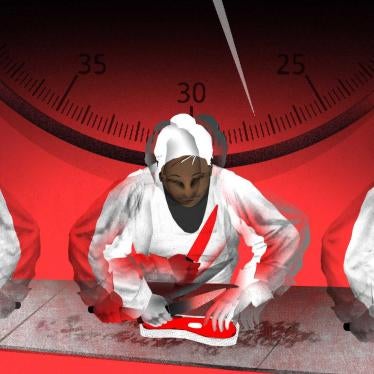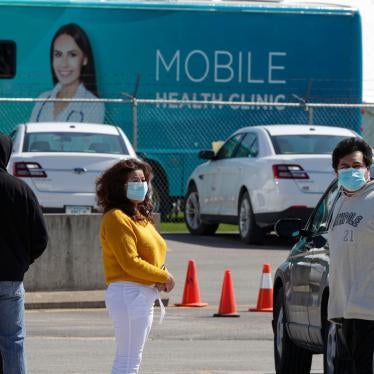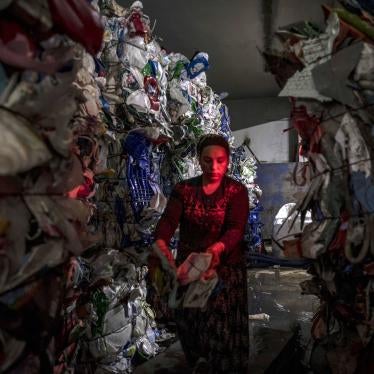To Whom it May Concern:
We are writing on behalf of Human Rights Watch to submit comments and recommendations to the Occupational Safety and Health Administration (OSHA), urging the agency to ensure that workers are protected from retaliation, particularly for raising workplace safety concerns related to the coronavirus pandemic.
Fear of retaliation undermines both the human rights of workers and OSHA’s ability to discharge its mandate. OSHA can and should do more to protect workers who raise concerns about safety and health violations in their workplaces, including dramatically increasing worksite inspections, becoming a certifying agency for U visas, and ensuring that workers’ organizations are integrated into the health and safety oversight process.
Human Rights Watch is a nonprofit, nongovernmental human rights organization. We operate in 90 countries and have been investigating, documenting, and exposing human rights abuses around the world for more than four decades. We have published several reports on violations of workers’ rights in the United States. Our most recent report, “When We’re Dead and Buried, Our Bones Will Keep Hurting”: Workers’ Rights Under Threat in US Meat and Poultry Plants, released in September 2019, documented how federal deregulation threatened to worsen dangerous working conditions in the meatpacking industry.[1]
Meat and poultry processing workers already had some of the highest rates of occupational injury and illness in the United States prior to the Covid-19 pandemic.[2] In 2019, federal OSHA data showed that a worker in the meat and poultry industry lost a body part or was sent to the hospital for in-patient treatment about every other day.[3] And between 2013 and 2017, eight workers died, on average, each year because of an incident in their plant.[4]
During our reporting, workers from pork, beef, and chicken slaughter and processing plants across the country shared experiences with us that demonstrated the need for much stronger protections for workers who want to speak out about conditions or report safety and health violations in their workplaces.
In general, workers whom Human Rights Watch interviewed for this research frequently raised fears of retaliation. Most of the workers who spoke with us requested to remain unidentified in our report, with many of these individuals expressing fears of retaliation from their employer or potential immigration consequences if they were identified.[5]
This fear was particularly acute when discussing the reporting of injuries and illnesses within plants. Many workers said that they feared drawing attention to themselves and incurring negative repercussions from supervisors by reporting an injury or leaving their station to seek medical care.[6] In one example, a worker at a beef plant in Nebraska reported that his former supervisor had prevented him from promptly reporting an injury, telling him bluntly, “If you [report] the pain, I’m going to be on top of you, I’m going to make your life impossible.”[7]
Indeed, a perception among some workers we interviewed was that supervisors at meat and poultry plants were keen to penalize workers for reporting injuries or complaining about illnesses.[8] It is no wonder, then, that a 2016 survey of Arkansas poultry workers by the Northwest Arkansas Workers Justice Center found that 57 percent of workers reported not taking any action following an injury at work.[9] Similarly, a 2013 survey of Alabama poultry workers by the Southern Poverty Law Center found that workers did not report 40 percent of work-related injuries.[10]
Several studies have found that immigrant workers are especially likely not to report injuries.[11] One undocumented poultry worker frankly summarized the way that immigration status impacts undocumented workers’ ability to speak up about health and safety conditions: “We don’t work with our real names, so we are afraid.”[12]
As studies from OSHA, the Government Accountability Office, Department of Health and Human Services, Centers for Disease Control and Prevention, National Institute for Occupational Safety & Health, and peer-reviewed medical publications have shown, federal occupational injury and illness data do not accurately reflect workers’ experiences or conditions.[13]
Workers who are too afraid to report an injury do not show up in injury and illness data. Inaccurate injury and illness data, in turn, hides incidents and trends, which are necessary to identify unscrupulous employers and exploitative workplaces, to develop effective remediation programs and strategies, and—ultimately—to prevent abuses of workers’ human right to workplace health and safety. In short, fear of retaliation fundamentally undermines both the human rights of workers and OSHA’s ability to discharge its mandate.
But fear of retaliation also prevents workers from speaking out about working conditions that place them in danger. In the meatpacking industry, this was particularly true when it came to work speeds.
Workers we spoke with described feeling like they were in a triple-bind when the speed of the line—which ferries animals on hooks, chains, and belts through slaughter and processing—was faster than they felt was safe for the number of workers at their station.[14] If they complained to their supervisors about the speed and requested that they slow it down, the workers feared that they may be berated, threatened with termination, or told to quit.[15] If the workers tried to push themselves to work at the same speeds, but made mistakes while keeping up with the pace, they feared they may be berated or threatened with termination.[16] But if they pushed themselves to keep pace and actually did their job without mistakes, they felt like they were putting themselves at increased risk of serious injury and illness and feared that their employers may see this as evidence that fewer workers are needed to do their job.[17]
As another Nebraska beef worker said, “The company likes the supervisors that keep the line moving. … If you’re slow… the supervisors get annoyed… they come and intimidate [the workers].… There isn’t anybody who can speak up to them—the supervisors are untouchable. No one listens to [the line workers].”[18]
Fear of retaliation contributed to abusive and exploitative working conditions before the pandemic. But the already-dangerous conditions we documented in 2019 only became more dangerous—and for some, deadly—when the coronavirus pandemic began.
More than 50,000 meat and poultry processing workers contracted Covid-19 and at least 250 workers have died of the virus, according to tracking by the Midwest Center for Investigative Reporting.[19] As previously noted, between 2013 and 2017, eight workers died, on average, each year because of an incident in their plant.[20] Now, we cannot say for certain that 250 workers in the industry died of a coronavirus infection that they were exposed to at work—although this lack of data is certainly part of a larger problem. But if we accept this figure, then the coronavirus made working in the meatpacking industry during the year since the pandemic began more than 30-times deadlier.
As the pandemic intensified in 2020, workers in the meatpacking industry described to nongovernmental organizations the crowded working conditions, pressure to continue working through illness, and denial of personal protective equipment.[21] They reported that companies were slow to implement measures to ensure social distancing in their facilities.[22]
In response, Human Rights Watch joined a number of civil society and workers organizations in April 2020 to call for improved health and safety conditions in plants during the pandemic, paid sick and family leave for workers caring for themselves or others, premium pay for hazardous work, and protection against retaliation.[23]
The US government, and OSHA in particular, can and should do more to protect workers from retaliation. But OSHA, which creates and enforces worker safety and health regulations, has been unable to effectively exercise its statutory powers to investigate workplace conditions and penalize businesses that violate workers’ rights.[24]
Under the last administration, the agency operated with the fewest safety and health inspectors in its 48-year history.[25] A recent analysis of Covid-19-related retaliation complaints to OSHA by the National Employment Law Project found that from the beginning of the pandemic to August 8, 2020, only one in five Covid-19-related retaliation complaints were docketed for investigation and only 2 percent were resolved in that period.[26] OSHA’s decline in enforcement activity has a particularly devastating impact on Black and Latinx workers, including immigrants, with Black and Latinx workers suffering higher fatality rates than other workers.[27]
Without effective oversight and accountability, abusive employers will continue to explicitly and implicitly use the threat of retaliation to stifle dissent and obscure their health and safety impacts. Without addressing this, OSHA cannot carry out its mandate to protect workers’ health and safety. As such, Human Rights Watch urges OSHA to dramatically increase its oversight and inspection capacity by increasing the number of Compliance Safety and Health Officers, returning at least to the officer-to-workforce ratio that existed in previous decades.
Moreover, OSHA can do more to address the underlying vulnerability of undocumented workers to threats based on their immigration status. The agency should have a stronger role in protecting undocumented workers from deportation by becoming a certifying agency for U visas, like the US Equal Employment Opportunity Commission, ideally through legislation that provides protection similar to U visas for workers who suffer abuses or retaliation resulting from workplace health and safety violations.
The agency should also affirm workers’ freedom of association and right to collective bargaining, provide guidance on safety and health clauses in collective bargaining agreements in the industry, and ensure that meatpacking plant managers meaningfully engage with workers on health and safety concerns through their democratically elected union representatives, health and safety committees, and worker center advocates.
Thank you for the opportunity to submit a comment. We would be happy to provide additional information, and also welcome the opportunity to further discuss these issues. If you would like to arrange such a meeting, please contact Grace Meng at mengg@hrw.org.
Sincerely,
Grace Meng
Associate US Director
Matt McConnell
Researcher, Business and Human Rights
[1] Human Rights Watch, “’When We’re Dead and Buried, Our Bones Will Keep Hurting’: Workers’ Rights Under Threat in US Meat and Poultry Plants” (September 4, 2021) https://www.hrw.org/report/2019/09/04/when-were-dead-and-buried-our-bones-will-keep-hurting/workers-rights-under-threat.
[2] See id., pp. 32-33 (“Although the rate of injury and illness for meat and poultry workers has declined alongside manufacturing in the United States, generally, the rate remains significantly higher than the average for manufacturing workers. In 2017, meatpacking workers were nearly twice as likely to suffer an injury and more than 15-times as likely to suffer an occupational illness than the average private-sector worker—the second-highest rate of occupational illness among all US industries that year. Over the past decade, workers at hog and cattle plants have had a higher average rate of recordable occupational injuries and illnesses than police officers or workers at sawmills—more than twice the national average for private sector workers.”).
[3] Id., p. 29 (Human Rights Watch data analysis of OSHA Severe Injury Data between January 1, 2015 to July 31, 2018. The scope of the geographically limited data set includes 1,308 days, over which 770 severe injuries were reported from establishments within the three NAICS industries covered by this report).
[4] Id., p. 30 (This figure excludes worker fatalities stemming from transportation incidents from the total worker deaths in the BLS Census of Fatal Occupational Injuries for the Animal Slaughtering and Processing Industry (NAICS 31161) between 2013 and 2017).
[5] For more information about our methodology for this report and the demographics of individuals with whom we spoke, please see id. pp. 10-12.
[6] Id., p. 45.
[7] Id. (citing Human Rights Watch interview with Abel S., a pseudonym, Nebraska, March 8, 2019).
[8] Id.
[9] Id. (citing Northwest Arkansas Workers’ Justice Center, “Wages and Working Conditions” (February 1, 2016) https://www.uusc.org/sites/default/files/wages_and_working_conditions_in_arkansas_poultry_plants.pdf, p. 27).
[10] Id., pp. 45-46 (“The Southern Poverty Law Center’s survey of Alabama poultry workers also found that 66 percent of workers reported that workers were scared or reluctant to report injuries. Of these workers, 78 percent attributed this reluctance to fear of being fired.”) (citing Southern Poverty Law Center and Alabama Appleseed, “Unsafe at These Speeds: Alabama’s Poultry Industry and its Disposable Workers” (February 28, 2013) https://www.splcenter.org/sites/default/files/Unsafe_at_These_Speeds_web.pdf at pp. 14, 16).
[11] Id., p. 46, FN. 121 (citing several publications in support).
[12] Id., 20 (citing Human Rights Watch interview with Rosa P., a pseudonym).
[13] See id., pp. 42-43, fn. 108 (citing research from these sources finding federal data on occupational injuries and illnesses inaccurate).
[14] For more discussion of this dynamic, please see id., pp. 66-71 (“Inadequate Staffing and Mistreatment). Additionally, for more information about the relationship between line speeds and occupational injury and illness in the animal slaughter and processing industry, please see id., pp. 28-33 (“Federal Data on Workers’ Injury and Illness”); pp. 33-39 (“Systemic Risks for Worker Health and Safety, Cumulative Trauma Injuries and Musculoskeletal Disorders”); pp. 49-55 (“Maximum Slaughter Line Speeds”).
[15] Id., p. 69.
[16] Id.
[17] Id.
[18] Id., p. 53.
[19] Midwest Center for Investigative Reporting, “Tracking Covid-19’s impact on meatpacking workers and industry” (April 16, 2020) https://investigatemidwest.org/2020/04/16/tracking-covid-19s-impact-on-meatpacking-workers-and-industry/.
[20] Human Rights Watch, “’When We’re Dead and Buried, Our Bones Will Keep Hurting’: Workers’ Rights Under Threat in US Meat and Poultry Plants” (September 4, 2021) https://www.hrw.org/report/2019/09/04/when-were-dead-and-buried-our-bones-will-keep-hurting/workers-rights-under-threat at p. 30 (This figure excludes worker fatalities stemming from transportation incidents from the total worker deaths in the BLS’ Census of Fatal Occupational Injuries for the Animal Slaughtering and Processing Industry (NAICS 31161) between 2013 and 2017).
[21] Komala Ramachandra, “US Meatpacking Workers Face Crisis, Slashed Safety Protections During Pandemic,” Human Rights Watch (April 24, 2020) https://www.hrw.org/news/2020/04/24/us-meatpacking-workers-face-crisis-slashed-safety-protections-during-pandemic (citing William Bredderman, “Virus-Addled Meat-Packing Plant in Colorado Had ‘Work While Sick Culture,’ Authorities Say,” The Daily Beast (April 18, 2020) https://www.thedailybeast.com/jbs-meat-packing-plant-in-greeley-colorado-had-work-while-sick-culture-authorities-say).
[22] Id. (citing United Food and Commercial Workers, “UFCW Calls on USDA to Take Five Immediate Actions to Protect Meatpacking Workers and America’s Food Supply During Coronavirus Outbreak,” Press Release (April 20, 2020).
[23] Id. (citing Oxfam, et al., “Letter To The Poultry Industry On Protecting Workers During The Covid-19 Epidemic” (April 16, 2020) https://webassets.oxfamamerica.org/media/documents/Letter_to_Poultry_industry_Covid_19_response_4.pdf).
[24] For more information on this, please see id.,pp. 75-86 (“Section IV. The Way Forward”).
[25] Id., p. 78 (citing AFL-CIO, “Death on the Job: The Toll of Neglect, 2018” (April 2018) https://aflcio.org/reports/death-job-toll-neglect2018 at p. 109; Deborah Berkowitz, “Workplace Safety Enforcement Continues to Decline in Trump Administration,” National Employment Law Project (March 14, 2019) https://www.nelp.org/publication/workplace-safetyenforcement-continues-decline-trump-administration/).
[26] Deborah Berkowitz & Shayla Thompson, “Osha Must Protect Covid Whistleblowers Who File Retaliation Complaints,” National Employment Law Project (October 8, 2020) https://www.nelp.org/publication/osha-failed-protect-whistleblowers-filed-covid-retaliation-complaints/.
[27] US Bureau of Labor Statistics, Economic News Release, Census of Fatal Occupational Injuries Summary, 2019 (Dec. 16, 2020) https://www.bls.gov/news.release/cfoi.nr0.htm; Deborah Berkowitz, National Employment Law Project, Worker Safety in Crisis: The Cost of A Weakened OSHA (Apr. 28, 2020) https://www.nelp.org/publication/worker-safety-crisis-cost-weakened-osha.








